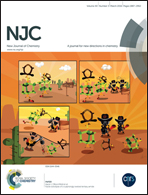Fabrication of innovative ZnO nanoflowers showing drastic biological activity†
Abstract
The present study deals with the synthesis of ZnO nanoflowers (ZnO-1 and ZnO-2) at room temperature using new structurally characterized single molecular precursors (1 and 2). 1, 2 and ZnO-1 were explored for their potential to reduce the viability of the Gram-negative bacteria Escherichia coli.1 and 2 were found to be promising antibacterial agents, while the ZnO nanoflowers demonstrated a relatively non-toxic nature. 1, 2 and ZnO-1 were further evaluated for DNA binding and cleavage behaviour. 1 and 2 showed strong binding affinity towards CT-DNA compared to ZnO-1. In addition, all the three compounds demonstrated oxidative cleavage of pBluescript plasmid DNA in the presence of H2O2.


 Please wait while we load your content...
Please wait while we load your content...